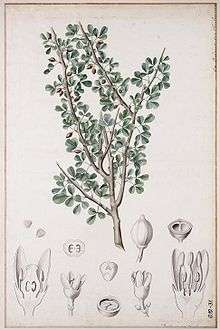Commiphora gileadensis
| Commiphora gileadensis | |
|---|---|
 | |
| Scientific classification | |
| Kingdom: | Plantae |
| (unranked): | Angiosperms |
| (unranked): | Eudicots |
| (unranked): | Rosids |
| Order: | Sapindales |
| Family: | Burseraceae |
| Genus: | Commiphora |
| Species: | C. gileadensis |
| Binomial name | |
| Commiphora gileadensis (L.) C.Chr | |
| Synonyms[1] | |
| |
Commiphora gileadensis, the Arabian balsam tree is a shrub species in the genus Commiphora growing in Saudi Arabia, Yemen, southern Oman, and in southeast Egypt where it may have been introduced.[2] Other common names for the plant include balm of Gilead and Mecca myrrh,[3] but this is due to historical confusion between several plants and the historically important expensive perfumes and drugs obtained from them.[4] True balm of Gilead was very rare, and appears to have been produced from the unrelated tree Pistacia lentiscus.[4]
The plant was renowned for the expensive perfume that was thought to be produced from it, as well as for exceptional medicinal properties that were attributed to its sap, wood, bark, and seeds.[5]
The bark of the balsam tree is cut to cause the sap to flow out. This soon hardens, and has a sweet smell that quickly evaporates. The hardened resinous gum is chewed, is said to taste either like a lemon or like pine resin, and it is also burned as incense.[4]
References
- ↑ "The Plant List: A Working List of All Plant Species". Retrieved June 6, 2014.
- ↑ Ville de Geneve - CJB - Base de données des plantes d'Afrique (French)
- ↑ "USDA GRIN Taxonomy". Retrieved 6 June 2014.
- 1 2 3 Groom, N. (1981). Frankincense and Myrrh: A Study of the Arabian Incense Trade. London and New York: Longman, Librairie de Liban. ISBN 0-582-76476-9.
- ↑ David Iluz; Miri Hoffman; Nechama Gilboa-Garber; Zohar Amar (2010). "Medicinal properties of Commiphora gileadensis" (pdf). African Journal of Pharmacy and Pharmacology. pp. 516–520. Retrieved 2014-06-07.